GBFE Conference Sessions 2023: Talk the talk
This year’s Great British Fleet Event’s Masterclass conference provided an opportunity for experts to offer advice, guidance and real-life examples of running fleets. John Challen reports.
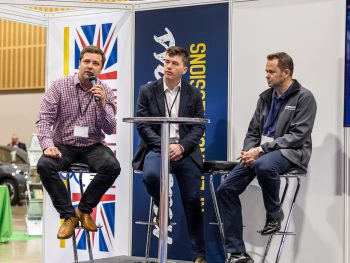
Session 1 speakers L-R: Paul Stephenson of Fleet Operations; James Garlick of British Gas; Northgate’s Joshua Hooper
Addressing a packed audience, Paul Stephenson, strategic account manager at Fleet Operations, kicked off the day’s proceedings by offering a reality check when it comes to managing an ageing pre-EV fleet. He highlighted the challenges facing fleets, including vehicle supply and the transition to an EV fleet. Rising fuel and maintenance costs were not helping fleets be as efficient as they could be, he also noted.
Stephenson suggested moving from a reactive to a proactive approach within fleets, where there is more information gathered about the vehicles and their operation. Keeping a closer eye on drivers, he said, would also make them more valued to the business.
Finally, he urged fleet managers to embrace driver training, because it can help reduce wear and tear and also the time vehicles are off the road.
Next up was James Garlick, head of commercial, electric vehicles, at British Gas. He talked about the company’s Hive product, which now included home charging for EVs on the British Gas fleet. Garlick noted that vehicle chargers were often included by OEMs or as part of salary sacrifice agreements. Meanwhile, he revealed that, to help the transition to EV, British Gas had introduced interest-free credit schemes on its chargers for customers. The advantage with the Hive app was the ability to auto- schedule cheaper tariffs to ensure charging costs are minimised.
The subject of net zero dominated the presentation of the next speaker – Joshua Hooper, head of product development, Northgate.
He started by focusing on the challenges of transitioning to an EV fleet, but added that the wider picture is the need for decarbonisation.
Those people working in fleet had a big part to play in the drive to net zero by 2050, Hooper told the audience.
With transport responsible for 24% of all greenhouse gas emissions, 19% was down to cars and vans.
Electric avenues
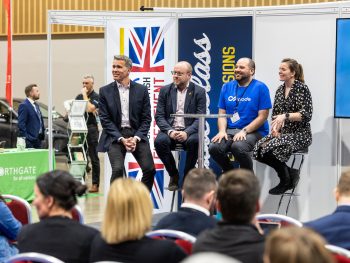
Session 2 speakers L-R: Co Charger’s Joel Teague; eLCV consultant Paul Kirby; Dan Lawrence-Eyre of Diode; Elizabeth Culwick from OZEV
The second session covered the subject of electric vehicles and began with Elizabeth Culwick, deputy head of the Office for Zero Emission Vehicles (OZEV) taking to the stage. She spoke about funding and regulations and the framework required in the transition to EVs. Culwick pointed out that the UK government’s targets for 2035 and 2050 are ambitious, but also achievable. The approach to decarbonisation and, ultimately, net zero, would “help cement the UK’s role as a leader in design and manufacture of electric vehicles,” she said.
OZEV’s spokesperson went on to state that 16.6% of cars sold in 2022 were BEVs. She acknowledged that they cost more, but reminded the audience that grants had been offset to cover the cost of such price hikes. Importantly, Culwick added that grants were still in place for some commercial vehicles, taxis and motorcycles, as well as the van grant, which will run until 2024/5.
Next up was Dan Lawrence-Eyre, co-founder and COO of Diode. His aim was to show how switching to EVs could be simplified – telling the audience he’d learned a lot from his time in the automotive sector, but also in the worlds of banking and energy.
According to Lawrence-Eyre, there are four Es to simplifying the switch to EVs: engage; educate; empower and enable.
The third speaker in the electric vehicle session at GBFE’s Masterclass was eLCV consultant Paul Kirby. He told the audience how he had set up his new business – EV Essentials – to give a voice to vans, especially as fleets are looking to transition to EVs.
Kirby pointed out that there were just over six years to create a new way forward for transport, warning that it was so much more involved than merely replacing the odd ICE-powered van with an EV.
The final speaker in the session was Joel Teague, CEO of Co-Charger, who reassured delegates that it was OK to not have all the answers when it came to knowing the right path to an EV fleet.
He put forward the idea of community charging via Co-Charger – bolstered by a community that rents out their driveways and/or EV chargers for fleets to potentially use. Teague added that the network was to become the second largest one for electric vehicles in the UK. With 14,000 registered users – and one driver who had used Co-Charger points more than 400 times – it is an area of the market that is one to watch. It could also be a big positive in the overall UK EV charging network.
Time to move
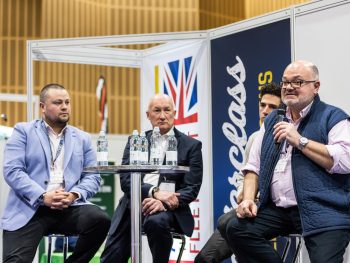
Session 3 speakers L-R: TfL’s Simon Cordery, Rick Nimbley of Geotab; Mark Dickens of Mobilize Power Solution; Tristram Benson from Engineius
The third session of the day concentrated on mobility and logistics, where Simon Cordery, senior property and commercial project manager, Transport for London (TfL) talked EV infrastructure – specifically, its role in decarbonising urban fleet networks.
He stated EV uptake in London had reached 30,000 units – around 3% of the car and van fleet. To support these vehicles, there were 820 rapid and 10,000 fast chargers in the region, with more on their way to fill some gaps in Zone 6 of the capital.
Cordery revealed that TfL had supported three rapid charging hubs – in Stratford, Woolwich and the City of London. He also added that over 70% of all of London’s chargers were used five or more times a day. Outlining the potential issues ahead, Cordery forecast that there would be up to 1.4m BEVs in London by 2030, which meant between 40,000 and 60,000 were required.
Geotab’s business development manager, Rick Nimbley was next up, talking cost control and the advantages of running an agile fleet. He stated that centralisation of data was key to success and then providing it to areas of the fleet that can make a difference. Running a fleet in this way, Nimbley suggested, offered simplicity and provided the information required in a more agile manner. He stated that this approach would be especially helpful for fleets transitioning to EVs, because there, the information is vital to make important decisions.
Mark Dickens, managing director at Mobilize Power Solutions, then used his time on stage to remind the audience that there was no ‘one-size-fits-all’ solution to transitioning to EVs. He noted that AC charging is the most efficient, but DC is essential when drivers are short on time. With regards the latter option, Dickens said it was important to get the right vehicles for the job and to train the drivers in using the right equipment for their vehicles. As a result, he claimed driver training for EVs should be the main priority when moving away from an ICE fleet.
The final speaker in this session was Tristram Benson, commercial director at vehicle movement company Engineius. He used his time to talk about innovation and the disruption within the automotive sector.
Benson said Engineius existed not just to offer technology to market, but to also offer services, such as his company’s ‘Snap, Chat and Move’ approach. The service was one of many vehicle valuation offerings that had been created in recent times and involved going to a driver’s house for a vehicle inspection and sending a message to a dealer (snap), the Engineius driver talking to the customer and the dealership (chat) and then, finally, taking the vehicle to its final destination (move).
Be sustainable to survive
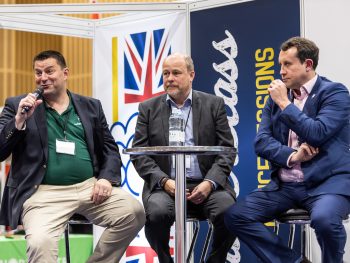
Session 4 speakers L-R: Simon King at Edenseven; Chris Chandler from Lex Autolease; Addison Lee’s Andrew Wescott
A session on sustainability at GBFE’s Masterclass followed, beginning with some real-life fleet experience from Addison Lee. Andrew Wescott, the company’s director of sustainability and regulation, explained how the company had started the shift to EV in spring 2021 and rolled out Volkswagen ID.4s from the autumn of that year. At the time of speaking to the audience, he confirmed that the company had ordered 2,000 vehicles and was half way to getting them all to drivers.
Wescott said there were initially three major groups of people in the project: drivers; customers and employees. While that focus hasn’t shifted, he said that lots of lessons had been learned. With drivers, he reported that range anxiety was the biggest concern – and still is.
Moving onto customers, he confirmed a lot of businesses had got onboard with the change, partly because of their own sustainability targets and pledges. The biggest challenge was the difference in vehicle, but Wescott reported that there were no major issues and that the sustainability benefits outweighed the need to move from one model to another.
Next up was Chris Chandler, fleet consultant at Lex Autolease, who addressed misinformation around EVs and how to deal with it. He told the audience that 50% of Lex deliveries are BEV or PHEV and that one in 10 EVs on the market are funded by the company. He was quick to point out that Lex had run EVs for a number of years and suffered no issues with battery degradation, nor going through a car wash and no EVs had spontaneously combusted!
In Chandler’s experience, he said the drivers like driving EVs and many had realised that range anxiety need not be an issue because they effectively had a ‘fuel pump’ at their house. One thing he highlighted was the need to plan journeys carefully. Leaving more time leads to less stress and risk of running late, he argued, while charging also gave drivers a chance to catch up on emails, increasing their efficiency while out on the road.
Simon King, a partner at Edenseven, then told the audience that sustainability done well should drive a company’s performance. If drivers aren’t doing things properly, he argued, there’s a cost to the business. When transitioning to an EV fleet, King argued that the area to spend the least time on is the vehicle itself. The best strategy should be to concentrate on the infrastructure and, to a slightly lesser degree, driver awareness.
On infrastructure, King made the point that there was no use having rapid chargers if a business has long dwell times. In this situation, 7kW chargers would be a better option. However, to make an informed decision such as that one, it is imperative to understand the data involved.
A glimpse at the road ahead
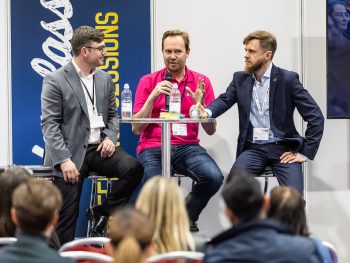
Final session speakers L-R: Antony Ursell from Michelin Connected Fleet; Paua’s Niall Riddell; Aliaksandr Kuushynau, Gurtam’s head of Wialon
The final session of the day looked, fittingly, at the future of fleets, where Aliaksandr Kuushynau, Gurtam’s head of Wialon, spoke first about how fleet management could be transformed with video telematics.
Kuushynau said that, as a company, Gurtam wanted to make life easier for fleets, who typically have to juggle an ever-increasing number of apps and programmes that are required for their work. The solution, according to Gurtam is the Wialon platform, which provides a single central place for all relevant information and apps. Kuushynau explained that the Wialon ecosystem included: tachograph; asset trackers; personal trackers; OBD tools; video monitoring and other additional hardware.
An important element for the future would be video, he told the audience – and Wialon’s integrated cameras use AI to identify potential issues or areas of improvement for fleets. For example, he said that the video can identify if a driver is smoking, when they are distracted, tired or using excessive acceleration or braking.
The penultimate speaker of the day was Antony Ursell, product manager, EV and green mobility, Michelin Connected Fleet. He first outlined the current practical challenges facing fleets, such as targets and expectations around adopting EVs, the need to prove a company’s environmental credentials and clean air zones that restrict vehicle movement.
“It requires energy to make more effort,” he reasoned. “We’re looking at consequence planning with customers to drive success.” Ursell said that part of Michelin Connected Fleet’s role was to benchmark emissions, analyse data and then provide action steps to facilitate improvements. In one case study, looking at year-on-year improvements, Ursell explained that with his company’s help, one fleet had reduced fuel consumption by 13.4%, idling by 14% and CO2 emissions by 4%. At the same time, there was a 17% increase in the number of EVs on the fleet.
Closing the day’s proceedings was Paua’s CEO, Niall Riddell, who spoke about the optimisation of EV fleet charging. The e-mobility transition means ‘fuelling’ shifts from one location to three (compared with ICE): public; home and workplace. This situation presents many challenges, but Paua, he said, is aiming to get more chargers into the hands of drivers. “We want to help fleets on the road and we are building the Paua network to help make that happen,” he commented. “Charging isn’t about location, it’s about availability.”












